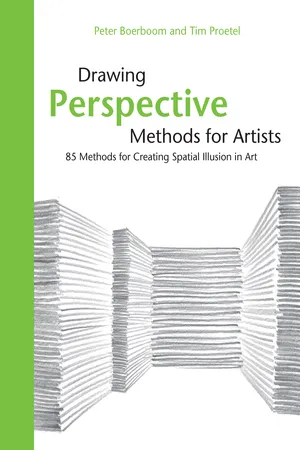
Drawing Perspective Methods for Artists
85 Methods for Creating Spatial Illusion in Art
- 192 pages
- English
- ePUB (mobile friendly)
- Available on iOS & Android
Drawing Perspective Methods for Artists
85 Methods for Creating Spatial Illusion in Art
About this book
Learn how to create the illusion of three-dimensional space in your drawings
It is as mundane as it is astounding: placed in the right way, a couple of lines on paper create three-dimensional space. To be more exact, the illusion of space.
The interest in three-dimensional drawing may initially arise from the intention to depict visible reality. However, the creation of depth is a fascinating challenge in every artistic composition. Drawing Perspective Methods for Artists is suitable for beginners and professionals alike. Authors Peter Boerboom and Tim Proetel have arranged, commented on, and with a guiding hand intuitively and tangibly presented 85 fundamental methods of three-dimensional illustration, offering a refreshing, simple approach to the graphic depiction of three-dimensionality.
Frequently asked questions
- Essential is ideal for learners and professionals who enjoy exploring a wide range of subjects. Access the Essential Library with 800,000+ trusted titles and best-sellers across business, personal growth, and the humanities. Includes unlimited reading time and Standard Read Aloud voice.
- Complete: Perfect for advanced learners and researchers needing full, unrestricted access. Unlock 1.4M+ books across hundreds of subjects, including academic and specialized titles. The Complete Plan also includes advanced features like Premium Read Aloud and Research Assistant.
Please note we cannot support devices running on iOS 13 and Android 7 or earlier. Learn more about using the app.
Information
1. Big and Small












Table of contents
- Cover
- Title Page
- Contents
- The Spatial Illusion
- 1. Big and Small
- 2. Overlap
- 3. Folds and Waves
- 4. Vanishing Points
- 5. Shape
- 6. Fade
- 7. Blur
- 8. Shadow and Environment
- Definitions
- About the Authors
- Copyright